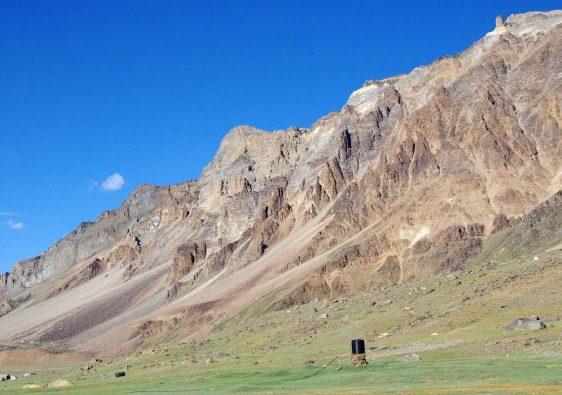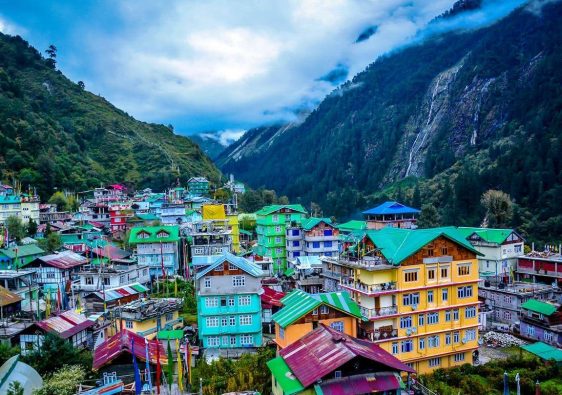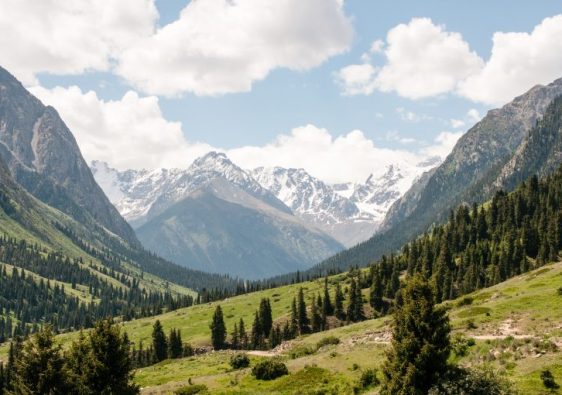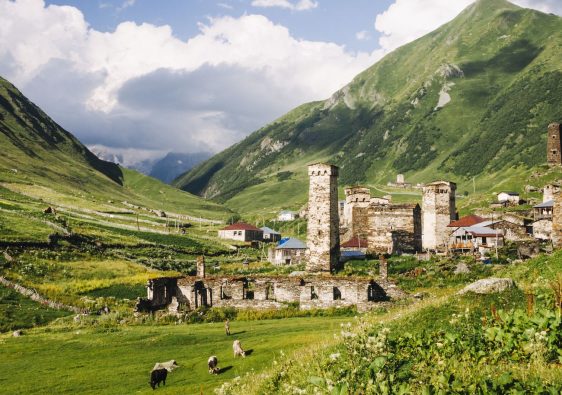Famously known as “BROKEN MOONLAND” because, in winter, the whole valley looks like the landscape of the moon, Nubra Valley is a Tri-armed valley, which is located to the northeast of Ladakh valley and is formed by the Shyok River, which is a tributary of the Indus, and the Nubra or the Siachen River.
Did you know? Nubra Valley was originally called LDUMRA which means the valley of flowers. Now, it is also known as the Orchard of Ladakh that is surrounded by all the sides by snow-capped Himalayan ranges.
Nubra Valley is a remote yet never isolated place that captures the interest of tourists as well as a trekking destination. It is accessible through Khardungla la Pass.
The unmatched beauty of the valley fascinates many tourists. The Khardong village, Khalser, and Deskit are the main villages of Nubra valley. Nubra Valley is a must-visit place, if you miss this part, then you are almost missing the heart of the Ladakh.
Here are the 7 Amazing Places To Visit In Nubra Valley:
1. Yarab Tso Lake

Tucked away in the Nubra Valley, there is beautiful Yarab Tso Lake in the backdrop of snow-capped mountains and extensive plains, which give blue skies a very panoramic view.
Yarab Tso Lake is Ladakh’s best-kept secret that is situated some 15 km from Diskit Region and is believed as a sacred place in Ladakh. It is a high-altitude lake that is hidden in the Sumur Village and can only be reached by trekking uphill for 20 minutes. The charming lake with perfectly clear water, set in the midst of the contrasting rocky surroundings makes it a genuinely awesome site.
Tucked away from the hustle and bustle of the city, the feeling of tranquility experienced on visiting Yarab Tso Lake compensates for the fairly troublesome climb. But remember, this lake is regarded as one of the holiest and high altitude lakes in the Nubra Valley, Yarab Tso Lake is highly revered among the locals of the region. It is advised not to wash your feet or try to swim in this enrapturing lake. So, try to simply sit by the rocks, breathing in the unpolluted mountain air, relishing the sight of colorful prayer flags fluttering around the crystal clear aquamarine water, and experience the sense of calmness it brings.
If you are planning a trip to Ladakh, then the beautiful lakes here cannot be missed at any cost. These lakes are an integral part of the landscape here especially this pictorial lake holds crystal-clear water, and is still untouched by the outer world.
2. Panamik
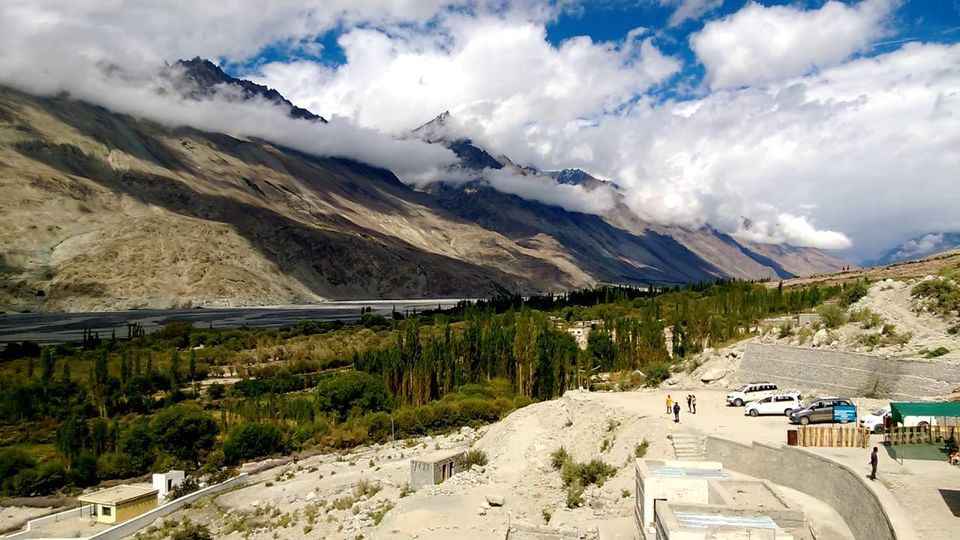
Famously known for its therapeutic hot springs, the Panamik is the last destination for tourists traveling across Ladakh which is a beautiful scenic village in the Nubra valley.
The hot water springs of Panamik are enriched with a high amount of Sulphur. A dip in these Sulphur hot springs is believed to cure various health ailments. Owing to the health benefits of these hot springs, the Panamik village is visited daily by the people from neighboring villages.
But this uninterrupted destination in Ladakh creates a heaven on earth ambiance. With the snow-clad peaks and rich green valleys, a visit to Panamik Village will truly amaze you. With the shadows formed by fluffy clouds above, you can see them pass you as you walk around the charming village.
As the region lies on the Indo-Tibetan border, it serves as a base for the trek to Ensa Monastery, which is famous for Buddhist murals. The tiny hamlet is also known for the Pashmina goats and the Bactrian camels which have two humps and were a great mode to transverse in the silk route.
Although everything about this place is captivating, the view of the sun-capped peaks and green valleys are truly mesmerizing. The panorama is more enchanting during the month of September and October when the trees turn yellow with a tinge of red. So, don’t miss it.
3. Diskit Monastery

Founded by Changzem Tserab Zangpo, a disciple of Tsong Khapa, founder of Gelugpa, in the 14th century, Diskit Monastery also known as Deskit Gompa or Diskit Gompa is the oldest and largest Buddhist monastery in the Nubra Valley of Ladakh, northern India.
Diskit Monastery is often said to be the oldest and the largest Buddhist Monastery in all Nubra Valley. The monastery’s most prominent attraction is the huge Maitreya Buddha statue atop it, which was inaugurated by HH Dalai Lama.
From the base of the statue, one can get a gorgeous panoramic view of the Nubra valley. The monastery is beautiful inside out. Within the Tibetian style Gompa, there are beautiful frescos and gompas. An iconic feature of the monastery is the statue of Cho Rinpoche (Crowned Buddha), which is a part of the prayer hall. Within the prayer hall, there are big drums and various images of the guardian deities.
The unmissable part of the monastery is the panoramic views of Nubra Valley that one can get to see from the top of the monastery which I mentioned above. You should visit the monastery for its vast collection of murals and displays of frescoes. Try to visit the monastery especially in December to attend the Dosmoche festival held here.
4. Maitreya Buddha Statue

Close to the oldest monastery of Nubra valley in Ladakh, Diskit monastery, lies the impressive statue of Jampa Buddha. One of the most prominent features of the Ladakh region, the statue of Maitreya Buddha is an impressive and stately structure.
Perched on top of a monastery, it is the statue of Jampa Buddha, noted for its intricate carvings, brilliant craftsmanship, and vivid colors. It is one of the prime and is deeply appreciated for its architecture. Facing the Shyok river, the statue sits tall with a height of 32 meters and was constructed with the help of the natives of the valley, and the gold used in the statue was donated by the heads of other major monasteries around.
Maitreya Budhha was constructed in 2006 keeping in mind three objectives – protection of Diskit Village, prevention of further war with Pakistan, and promoting world peace. The statue was inaugurated by H.H Dalai Lama in 2010. The imposing and colorful image, also known as Jampa is mounted on a large hall that has preserved a huge drum and a collection of statues and Buddhist literature.
You can see statues of Shakyamuni Buddha and Guru Rimpoche inside the hall. The best time to visit is in the summers between the months of June and September. You can easily hitch a ride onto a bus from Leh in order to reach this region.
5. Khardung La Pass
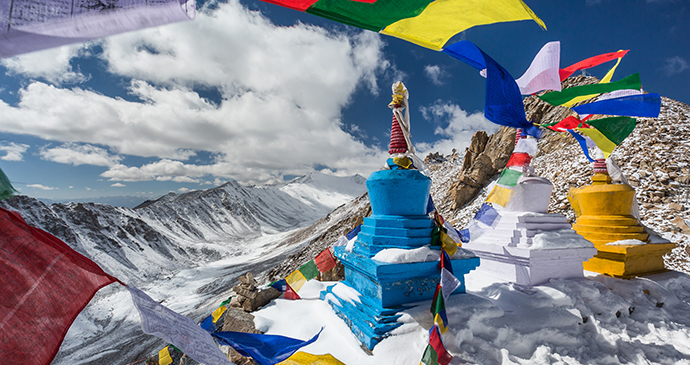
Khardung La is a mountain pass that local pronunciation is “Khardong La” or “Khardzong La” but, as with most names in Ladakh, the romanized spelling varies.
The pass on the Ladakh Range is north of Leh and is the gateway to the Shyok and Nubra valleys. Located at an altitude of 18,380 ft, Khardung La falls on an extremely scenic route in Ladakh that is one of the most popular tourist attractions in Ladakh, and for good reason. It is the highest motorable road in the world after all that offers astonishing views of the twisting roads up the mountain and the awesome valley.
This pass promises an escape from the regular destinations and it provides splendor sites for the naked eye. Alternatively known as the ‘Pass of Lower Castle’, Khardung La is the inspiration of motorbike, automobile, and mountain biking expeditions. This makes it an adventure aficionados’ paradise indeed.
A visit to Khardung La Pass is one of the must things to do in Ladakh. The picturesque panoramas and pure air lure tourists from every nook and corner of the world. Besides, how can one not admire the colorful prayer flags that simply add an added charm to your highway to glory?
6. Hundur Monastery
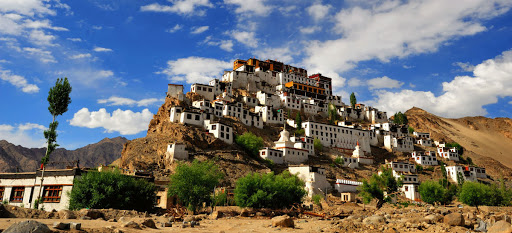
Located quite close to the Diskit monastery and Lachung temple, Hundur Monastery is a hilltop temple located in the Nubra Valley.
This ancient Buddhist religious site is also known as the Hundur Gompa, which is basically a small Buddhist fortification, enclosing years of Buddhist learnings and lineage. However, this part in Hundur marks the extent to which tourists are allowed into the village.
Also, there is a huge, beautiful statue of Buddha overlooking the mountains which is worth watching, its height is approximately 104 ft. If you like to explore then it’s a place for you, one of the farthest points till which the travelers are allowed. So, don’t miss it.
7. Samstanling Monastery
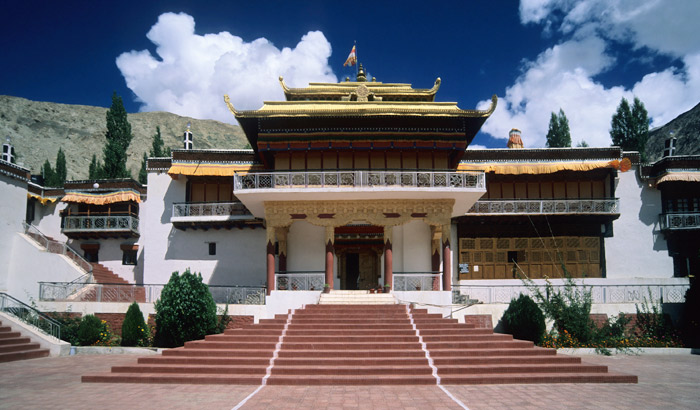
Located in Sumlur village of Nubra Valley, Samstanling Monastery was founded by Lama Tsultim Nima, 140 years ago which is considered to be an important Buddhist shrine.
Set amidst scenic mountains and greens Samstanling is a popular monastery that showcases the traditional touch with shades of gold, red and white. The entrance of the Monastery is lined with religious flags and the inside walls are lined with wall paintings representing Buddha and his lectures, Dharamchakra, the Four Heavenly Kings, and the other facts of Buddhism.
This blissful tourist interest place is dotted with trees blushed in red and yellow shades, colorful prayer flags, grey and golden mountains, and clear blue sky. The guest house in the monastery is the resident of the 7-year-old incarnation of Lama Bakula Rinpoche, who is a great visionary. The monastery also houses 50 monks. This must-visit attraction is approximately 120 km from Leh and a 45 minutes trek from Sumur village.
If you liked this article, then please subscribe to my YouTube Channel for Travel Adventures. You can also follow my adventures on Twitter and Instagram.

